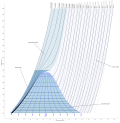Phase diagram
Phase Diagram
A phase diagram in physical chemistry, engineering, and materials science is a type of chart used to show the conditions (pressure, temperature, volume, etc.) under which thermodynamically distinct phases occur and coexist at equilibrium. Phase diagrams provide valuable information about melting, sublimation, boiling points, and the relationships between the solid, liquid, and gaseous states of matter. They are particularly useful in the fields of metallurgy and mineralogy for predicting the structures and compositions of minerals and alloys under different conditions.
Overview[edit]
Phase diagrams are graphical representations that map out the existence of different phases of a substance at various temperatures and pressures. The most common type of phase diagram is the temperature-pressure (T-P) diagram, although volume can also be a variable in more complex diagrams. Each region within a phase diagram represents a phase, and the lines that separate these regions are known as phase boundaries or transition lines, which indicate the conditions under which two phases can coexist in equilibrium.
Key Components[edit]
- Critical Point: The point on the phase diagram at which the properties of the gas and liquid phases of a substance become identical and form a single phase known as a supercritical fluid.
- Triple Point: The unique set of conditions at which all three phases (solid, liquid, and gas) of a substance coexist in thermodynamic equilibrium.
- Phase Boundaries: Lines on the phase diagram that mark the conditions under which two different phases can coexist in equilibrium.
- Eutectic Point: The lowest temperature at which a mixture of substances can coexist in a liquid phase.
Types of Phase Diagrams[edit]
- Binary Phase Diagrams: These diagrams represent the phase behavior of two-component systems. They are essential for understanding the melting and solidification behavior of alloys.
- Ternary Phase Diagrams: These involve three components and are more complex, often used in materials science to study the phase behavior of mixtures involving three elements or compounds.
- Pressure-Temperature Diagrams: The most common type, showing how phase transitions vary with changes in temperature and pressure.
Applications[edit]
Phase diagrams are crucial in various scientific and engineering fields. They are used to:
- Predict the conditions under which materials will undergo a phase change.
- Design chemical processes and select materials for specific temperatures and pressures.
- Understand and control the crystallization, melting, and alloying processes in metallurgy.
- Determine the stability and compatibility of components in geological and materials science studies.
See Also[edit]
-
Phase diagram of water simplified
-
Phase diagram
-
Mollier enthalpy entropy chart for steam - US units
-
Pressure-enthalpy chart for steam, in US units
-
Temperature-entropy chart for steam, imperial units
-
PVT 3D diagram
-
Eutektikum
-
Binary Boiling Point Diagram
-
Gibbs triangle ternary plot
-
Space diagram of a three-component system
-
Phase diagram of water
Ad. Transform your life with W8MD's Budget GLP-1 injections from $75


W8MD offers a medical weight loss program to lose weight in Philadelphia. Our physician-supervised medical weight loss provides:
- Weight loss injections in NYC (generic and brand names):
- Zepbound / Mounjaro, Wegovy / Ozempic, Saxenda
- Most insurances accepted or discounted self-pay rates. We will obtain insurance prior authorizations if needed.
- Generic GLP1 weight loss injections from $75 for the starting dose.
- Also offer prescription weight loss medications including Phentermine, Qsymia, Diethylpropion, Contrave etc.
NYC weight loss doctor appointmentsNYC weight loss doctor appointments
Start your NYC weight loss journey today at our NYC medical weight loss and Philadelphia medical weight loss clinics.
- Call 718-946-5500 to lose weight in NYC or for medical weight loss in Philadelphia 215-676-2334.
- Tags:NYC medical weight loss, Philadelphia lose weight Zepbound NYC, Budget GLP1 weight loss injections, Wegovy Philadelphia, Wegovy NYC, Philadelphia medical weight loss, Brookly weight loss and Wegovy NYC
|
WikiMD's Wellness Encyclopedia |
| Let Food Be Thy Medicine Medicine Thy Food - Hippocrates |
Medical Disclaimer: WikiMD is not a substitute for professional medical advice. The information on WikiMD is provided as an information resource only, may be incorrect, outdated or misleading, and is not to be used or relied on for any diagnostic or treatment purposes. Please consult your health care provider before making any healthcare decisions or for guidance about a specific medical condition. WikiMD expressly disclaims responsibility, and shall have no liability, for any damages, loss, injury, or liability whatsoever suffered as a result of your reliance on the information contained in this site. By visiting this site you agree to the foregoing terms and conditions, which may from time to time be changed or supplemented by WikiMD. If you do not agree to the foregoing terms and conditions, you should not enter or use this site. See full disclaimer.
Credits:Most images are courtesy of Wikimedia commons, and templates, categories Wikipedia, licensed under CC BY SA or similar.
Translate this page: - East Asian
中文,
日本,
한국어,
South Asian
हिन्दी,
தமிழ்,
తెలుగు,
Urdu,
ಕನ್ನಡ,
Southeast Asian
Indonesian,
Vietnamese,
Thai,
မြန်မာဘာသာ,
বাংলা
European
español,
Deutsch,
français,
Greek,
português do Brasil,
polski,
română,
русский,
Nederlands,
norsk,
svenska,
suomi,
Italian
Middle Eastern & African
عربى,
Turkish,
Persian,
Hebrew,
Afrikaans,
isiZulu,
Kiswahili,
Other
Bulgarian,
Hungarian,
Czech,
Swedish,
മലയാളം,
मराठी,
ਪੰਜਾਬੀ,
ગુજરાતી,
Portuguese,
Ukrainian











